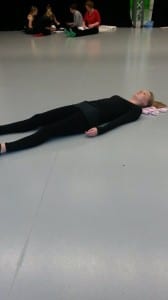Week Five 20/10/14 Contact research lab
‘How can we explore momentum alongside the idea of coming off the floor without using the support of our hands and how does this change when working with new or old partners?’
As a group we devised four tasks to help explore and answer our research question:
- Starting with skinesphere gradually integrating lower and upper kinesphere, without using your hands
- Inhalation and exhalation
- Trust exercise
- Structures and surfaces
To begin, I observed half of the group participating in task one. From watching their movement it was clear that other body parts played a greater role as the hands were not allowed to be used, for example the elbows and knees were mainly used to support the body where as the body, head and torso was used to move and travel around the space. When the first group begun the majority took it upon themselves to clasp their hands together in order to not use them, this idea was not discussed before hand. When watching the movement with clasped hands it looked extremely restrictive and tense, but on the other hand some interesting movement was created and the body’s were moving in a contortionist way. Half way through we asked the dancers to unclasp their hands and an immediate difference was seen, movement became less tense and freer. When I participated in the task I felt tension in my body, particular in my shoulders, when I had my hands clasped. I was aware that I stayed low to the ground and felt restricted in my movement. However when I unclasped I instantly became freer and my movement travelled more and higher levels were used, I felt my momentum increase more when there was not restriction. Our exploration of this first task saw that momentum was used more when hands were unclasped, yet many felt more aware of their hands and preferred to have them clasped as they would not use them. For me I preferred my hands unclasped as I did not like the restriction.
 Here is an image of one of dancers moving without using her hands.
Here is an image of one of dancers moving without using her hands.
For inhalation and exhalation we created more of a relaxation task to try and relive the tension that was created in the first task. The task was simply lying in a still neutral position focusing on breath to relax the muscles, mind and body. After this we repeated the first task to see if there was a difference. With the body in a relaxed frame I felt that I moved with more ease and fluidity as there was less tension, what’s more I found it easier to use and apply momentum as there was no tension holding me back. With this exploration we discovered that it was more beneficial to have a relaxed body when performing contact improvisation as your outcome is more effective.
 Here is an image of me during the relaxation task.
Here is an image of me during the relaxation task.
The third task consisted of a trust exercise that included the whole group, with one person in the middle the rest of the group created a safe circle around them which initiated the person in the centre to begin falling, relying on their weight to be caught and pushed back to somebody else. This task focused on the momentum of the person taking their weight off balance and also explored the importance of giving and taking weight. When observing the person in the middle you could clearly see their momentum shifting around the space and gradually building when they became more confident with the exercise. When I was the middle person I felt scared to fall even though I knew people were there to catch and support me, when I closed my eyes I could feel my momentum move me around the space. I will explore this feeling of momentum further in my next class by taking my weight off balance and pushing it to the limit to see where it takes me.
Our final task was to create surfaces and structures in partners as support mechanisms to balance and move on. Again this task was done without hands. When I participated I found myself using my back and head for support to replace my hands, I also found that I used my head to initiate my partners movement. Overall I found the task quite difficult to not use my hands as for me they are a main area of support during contact improvisation. I also found that my movement was on a higher level as I was less likely to place my hands on the floor for support.
Overall the research exploration was successful. Through the different tasks we had a more insightful understanding and physical feeling of momentum and how it effects your movement, I will take this on board when I’m performing and experimenting with contact improvisation to see where my momentum can take me and how it will affect other people. In addition to this it was interesting to not use your hands, at first it was difficult to move with others without the support of your hands, but largely more original and exciting movement was created. Again I will further this is my next class by using my hands less.
In Daniel Lepkoff article Contact Improvisation: A Question? He states how questioning contact improvisation is formulated and resides within the body, through its bones, muscles, organs, nerves and brain, not verbalised in the mind. (Lepkoff, 2008). Meaning when you pose questions it’s more effective to feel the answer through your body, this is something that I will apply when questioning improvisation.
Works Cited
Daniel Lepkoff (2008) Contact Improvisation: A Question?. [online] Available from http://www.daniellepkoff.com/Writings/CI%20A%20question.php [Accessed 19 October 2014].